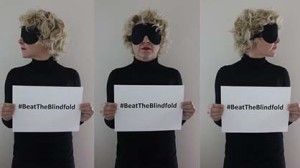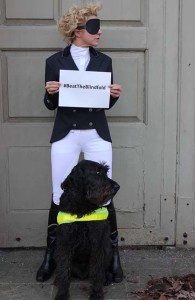Blind Riders Required to Wear Blindfolds…?
By: Brittany Bevis
There has been considerable discussion lately in the equestrian community surrounding a portion of the FEI Para-Equestrian Dressage Rules that requires some blind riders to wear blindfolds during competition. While it might seem like an oxymoron that a blind rider would be required to wear a blindfold, there is a reason for the ruling, according to the FEI (Federation Equestre International). More on that later…
This topic has been brought to the forefront this week thanks to a blind international Dressage rider, Verity Smith, who’s challenging the rule. Smith has competed in the past on behalf of her country as part of Para Team Great Britain and is hoping to compete at the Paralympics in Rio De Janerio in 2016. However, she’s concerned the rule will severely impact her chances, not only to qualify for Rio, but to ride in sanctioned competition entirely.
The petition goes on to say that this effort is intended to “revive the spirit of the Paralympics which invoke the ideals of courage, determination, inspiration, and equality. The Paralympic aim is to ‘challenge stereotypes, transform attitudes and redefine the boundaries of possibility.’ The blindfold removes these ideals. Therefore, we want to remove the blindfold and allow blind riders to compete using every glimmer of sight they may still have. Don’t blindfold their dreams.”
The actual rule Article 8427 Dress reads as follows:7. Athletes with Functional Profile 36 (totally blind), riding in Grade III, must wear a PE approved blindfold, blacked out glasses or goggles while competing. These may be subject to inspection by a PE competition official (e.g. Steward) immediately after the Athlete leaves the arena following the completion of the Test. An arm band, provided by the Athlete, in a distinctive colour must be worn at all times by Grade III and IV Athletes with visual impairment while mounted outside of the Competition.
The FEI spokesperson continues, “the blindfold rule has been in place for some time and is not a new rule. From January 1st, 2016, one significant change in the rules is that athletes will need to compete in the grade they are classified in by the International Blind Sports Federation.”
Classification of blind para-athletes is carried out by the International Blind Sports Federation, which recognizes three classes of visual impairment.
B1 – Totally or almost totally blind; from no light perception up to light perception but inability to recognize the shape of a hand. This is profile 36, Grade III.
As a rider with a functional profile of 36, competing in Grade III B1, Smith will be required to wear the blindfold.
The full FEI Para-Equestrian Dressage rules can be found at this link.
What’s your opinion on this topic?














